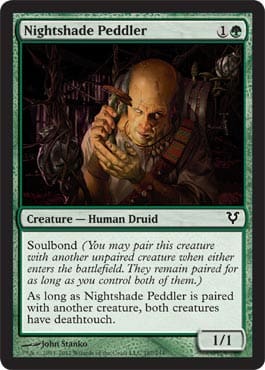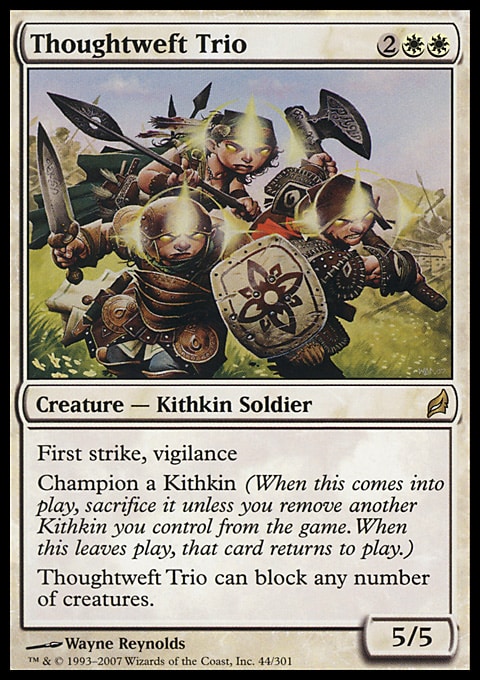Pro Tour: Avacyn Restored, being Innistrad Block Constructed, was full of Wolfir Silverhearts pumping Zealous Conscripts, Avacyn's Pilgrims, and whatever else might want +4/+4. (Bloodshot Trainee would like to move to Innistrad.) That’s soulbond professionally; what about casually? That, along with a first attempt at exploring black’s loner mechanic, is this week’s subject.
Ludo Snob
Besides making anagrams of soulbond, what’s available in the free market of paired creatures? Since this is a large, one-off set, we know we’re getting the twenty creatures we have and no more—for a long while at least. Grouping these nineteen in categories makes it easier:
Power and Toughness – Druid's Familiar (+2/+2), Trusted Forcemage (+1/+1), Wolfir Silverheart (+4/+4)
Keywords – Diregraf Escort (protection from Zombies), Elgaud Shieldmate (hexproof), Geist Trappers (reach), Hanweir Lancer (first strike), Lightning Mauler (haste), Nearheath Pilgrim (lifelink), Nightshade Peddler (deathtouch), Pathbreaker Wurm (trample), Silverblade Paladin (double strike), Spectral Gateguards (vigilance), Wingcrafter (flying)
Other – Deadeye Navigator (flickering), Galvanic Alchemist (untapping), Stern Mentor (Merfolk Mesmerist), Stonewright (Firebreathing), Tandem Lookout (Thieving Magpie)
That’s not the greatest space in the world for new exploration, but there’s some. Pathbreaker Wurm isn’t impressive in multiplayer when you can play Primal Rage for trample; Serra's Blessing is better than Spectral Gateguards; and so on through a number of keywords.
Nightshade Peddler is a little different, at least in green. You can play Equipment for deathtouch, of course, but this is the cheapest permanent way to give deathtouch. You don’t need to run W/B as with Vault of the Archangel; you don’t need to pay for the Equipment twice; you just pay
In Standard, until the cards I ordered from the set come in, I’m experimenting with Nightshade Peddler in a R/G shell with cards I already want to run, such as Daybreak Ranger, Huntmaster of the Fells, and Inferno Titan. These are great creatures as is, but deathtouch gives them relevance long after most red decks are done.
Also unlike Equipment, Nightshade Peddler lets you curve out much easier. If you see an opening on the fifth turn, lay down the Peddler to soulbond Inferno Titan to it next turn. If not, play the Titan with the Peddler afterward; you’ll still be fine. Peddler is probably more fragile in a normal circumstance than Equipment, but it’s also so much easier to use that it makes up the difference to me.
Of course, all that talk is for Standard, where the creatures are already good. What about in multiplayer? It turns out that creepy crawlers love some deathtouch:
"Spider Glider"
- Creatures (24)
- 2 Apocalypse Hydra
- 2 Cyclops Gladiator
- 4 Fire Ants
- 4 Nightshade Peddler
- 4 Silklash Spider
- 4 Valakut Fireboar
- 4 Vulshok Refugee
- Spells (12)
- 2 Creeping Renaissance
- 3 Magebane Armor
- 4 Whalebone Glider
- 3 Predator, Flagship
- Lands (24)
- 12 Mountain
- 8 Forest
- 4 Kazandu Refuge
I don’t normally list dual lands in the mana base since I rarely make decks with finicky needs, but Cyclops Gladiator wants ![]()
![]()
![]() while Silklash Spider wants frequent access to
while Silklash Spider wants frequent access to ![]()
![]() , so there’s a little tug on the mana. Any land making red and green is fine here.
, so there’s a little tug on the mana. Any land making red and green is fine here.
This is a mash-up of several deck styles, some my idea and some not. The deck’s core is Fire Ants/Silklash Spider and Nightshade Peddler. You can give deathtouch to the Ants or the Spider and clear the board in quick fashion. Peddler is better than Equipment in this deck because it takes a lot less mana to get it going; you can play it easily in the midgame even though you’ve been hiding it in your hand for a while. A third-turn Fire Ants followed by a fourth-turn Nightshade Peddler will kill your Peddler, but it’s also a quick pseudo-Wrath should you need one.
Ideally, of course, you can save your Nightshade Peddler. This is where Magebane Armor can fit, but it’s mostly where Whalebone Glider and Predator, Flagship are intended to shine. I love giving things flying just to kill them—feels like volleyball except I’m good at it—and in this deck, you can use Glider and Flagship to save your Peddler or Spider from death or use it to give a ground creature flying so Silklash Spider can kill it. Also, who’s going to take a Whalebone Glider seriously? The first few times you play the deck, you might buy some you’re-not-a-threat-because-you’re-playing-weak-cards points. That hasn’t worked with me for a long time, but hey . . . actually, that’s not quite true since I moved across the country and the people here have no knowledge of my former deeds. But it’s mostly true.
So, you have Fire Ants, Silklash Spider, Whalebone Glider, and Predator, Flagship working together to send things skyward for HURTMORE or HEALMORE. (Thou hast done well in defeating the Magidrakee. Thy experience increases by 5. Thy GOLD increases by 11. Also, I might like Dragon Warrior.) What else wants to go with it regardless of whether you draw Nightshade Peddler?
In the style of Rise of the Eldrazi Drafts with Goblin Tunneler, Whalebone Glider loves to give flying to Valakut Fireboar as a 7/1 pig of death. 7/1 seems fragile, but Silklash Spider can take care of enough little guys to make it worthwhile; alternatively, you could just swing at the person without flyers. Magebane Armor helps a little with the Boar while still allowing the Glider to pump it. (In case you’re wondering, Glider’s in here over Flying Carpet and other similar cards for curve considerations.)
Cyclops Gladiator loves both deathtouch and Magebane Armor. Magebane Armor, like Vulshok Refugee’s protection from red, lets you save a creature from the deadly sting of Fire Ants as well. Apocalypse Hydra does silly things in multiplayer, but worse things with deathtouch. Lastly, Creeping Renaissance is a way to repurchase parts of your combos as needed. If you need to kill your Peddler in an antoid rage, Creeping Renaissance lets you feel better about it.
I’ve rarely had fun with the pinging/deathtouch concept because it’s usually so straightforward that in a particular game, either someone has the ways to kill Prodigal Pyromancer and friends easily, in which case the deck loses easily, or the removal isn’t there, in which case the deck dominates. I don’t like inconsistency, especially when I’m meh on the deck concept anyway. This deck has a lot more play in the joints, a lot more chances to matter if you don’t draw the deathtouch, and flying Valakut Fireboars. All of this is good.
Keep Your Thoughtweft to Yourself
On the other side of Avacyn Restored is the loner mechanic, encouraging you to play one creature if you’re in black or few creatures if you’re blue. This is a tough nut to crack in multiplayer. Big creatures are targets, and players with just one creature are open. As a result, there aren’t many creatures you can feel comfortable with going solo.
The best incentives to go alone are Demonic Rising and Homicidal Seclusion. Rising compensates for some of the style cramp by adding big flyers to the board; importantly, this is at your end step, after you’ve taken any bonuses from attacking alone.
Chumping with 5/5s is a fine plan if you want to give your other creature some alone time. Homicidal Seclusion doesn’t seem like much, and ![]()
![]() is on the steep side, but +3/+1 and lifelink is surprisingly relevant. If you treat Seclusion as a kind of Loxodon Warhammer that never needs equipping, you see how it can make a difference. And unlike Demonic Rising or Fettergeist, Homicidal Seclusion is relevant in multiples.
is on the steep side, but +3/+1 and lifelink is surprisingly relevant. If you treat Seclusion as a kind of Loxodon Warhammer that never needs equipping, you see how it can make a difference. And unlike Demonic Rising or Fettergeist, Homicidal Seclusion is relevant in multiples.
My initial thought for solo creatures was of those that could block any number of creatures, such as Palace Guard. Avatar of Hope stood out in the Gatherer search for these creatures, but the most intriguing one was Thoughtweft Trio. Not only can it block any number of creatures, but its first-strike-and-vigilance combo lets it be involved in combat on your turn as well as your opponents’ turns.
Like all championing, Trio naturally lends itself to having fewer creatures while having backup should your creature die. And flavorwise, it’s amusing to take a swarming tribe such as the Kithkin and skew it through the loner mechanic. I don’t like swarm decks, and I especially don’t like losing to them like I did in Lorwyn-era Standard, so turning the Kithkin flavor on its head and forcing them to fight alone is hilarious to me. What Kithkin want to fight alone?
"The Lone Kithkin"
- Creatures (19)
- 3 Amrou Seekers
- 3 Mistmeadow Skulk
- 4 Figure of Destiny
- 4 Kithkin Harbinger
- 4 Thoughtweft Trio
- 1 Brigid, Hero of Kinsbaile
- Spells (17)
- 3 Emerge Unscathed
- 4 Shelter
- 4 Sunscour
- 2 Demonic Rising
- 4 Homicidal Seclusion
- Lands (24)
- 15 Plains
- 5 Swamp
- 4 Terramorphic Expanse
I have no idea what to make of this deck, as it’s so unlike anything else I’ve built. On the one hand, you can play this deck as a straight Kithkin midrange/evasion deck. Nobody would argue with the quality of Figure of Destiny, Thoughtweft Trio, or Brigid. Amrou Seekers is close to a Phantom Warrior, and Mistmeadow Skulk’s been the only Kithkin I normally enjoy playing, as the protection ability is unique, allowing it to either serve as a great blocker or be one of the only white creatures to avoid damage from Lightmine Field.
The heart of the loner interaction is with Homicidal Seclusion, Thoughtweft Trio, and Kithkin Harbinger. Championing a Harbinger means you can re-search for Thoughtweft Trio when a previous one dies. Shelter and Emerge Unscathed give protection to your one creature, and if that’s an 8/6 first striking vigilant lifelinker that can block any number of creatures (Trio plus Seclusion), you’re in good shape. Homicidal Seclusion’s nasty with Brigid as well should you need to Harbinge for her. Demonic Rising’s just a backup creature should you need more than one.
If the deck’s loner aspect is working, Sunscour turns the creatures in your hand into a free board sweep. Board sweep raises the odds your one creature will make a difference in the first place. Given that your best creature needs to champion something, you might need to be more selective in your Sunscour timing than normal, but the cards should work well enough together that you can shape a plan.
Kithkin annoy me, and the loner mechanic makes me nervous, but put them together, and the results are at least intriguing. I don’t know how to make Homicidal Seclusion work in multiplayer, but I suspect there’s at least one way to do it, and stapling it to one of the most team-oriented tribes amuses me enough to give it a go. Come to think of it, tribal loner is entertaining with any tribe you throw in.
Conclusion
Both soulbond and lonerism allow you to play cards that benefit other specific permanents without being Auras or Equipment. That’s interesting common ground, and this week’s decks play in that new space. I hope they’ve gotten your brain going on what you can do with Avacyn Restored.






























